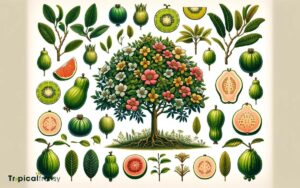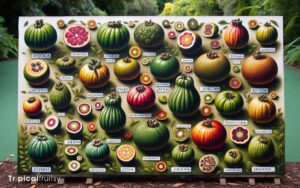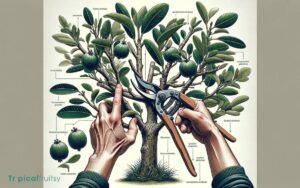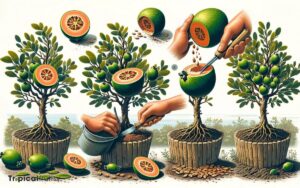How to Propagate Feijoa from Cuttings? 7 Easy Steps!
Propagating feijoa (Acca sellowiana) from cuttings is an excellent way to clone your favorite variety.
This cost-effective method involves taking semi-hardwood cuttings from a healthy feijoa plant, using rooting hormone, and providing the right conditions for root development.
Propagation of feijoa cuttings involves several steps:
Successfully propagated feijoa cuttings lead to new plants identical to the parent, enriching your garden’s diversity.
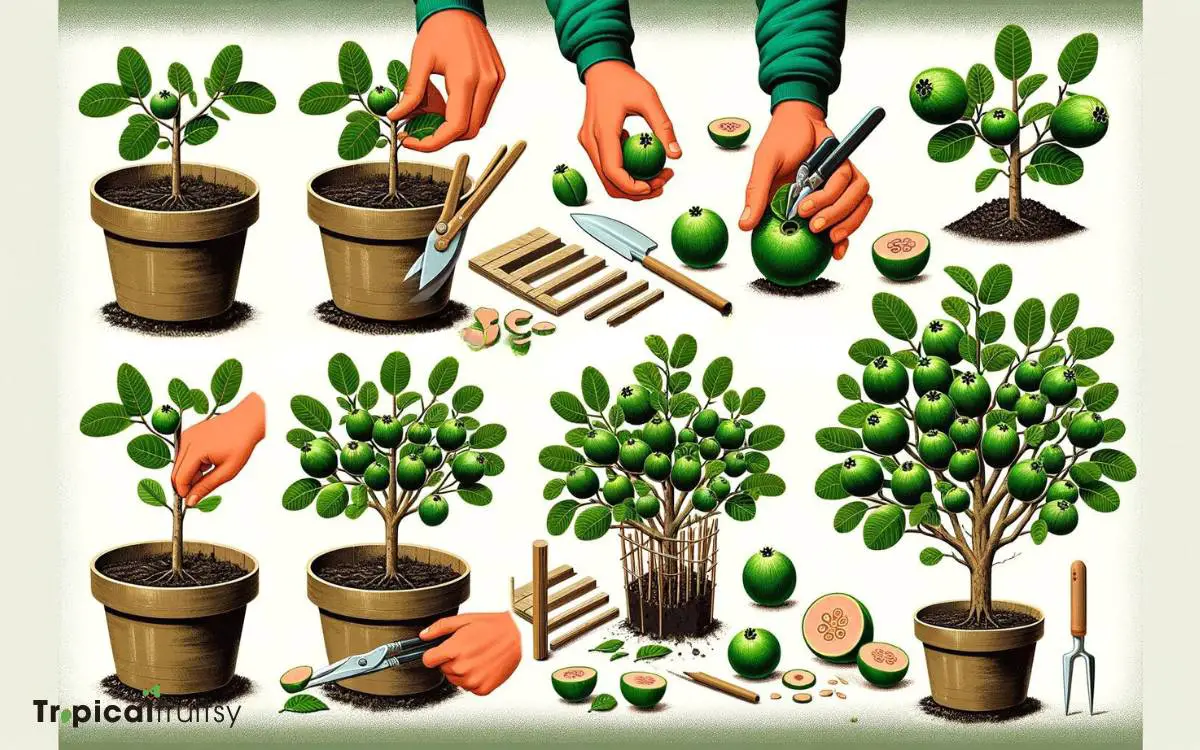
Key Takeaway
Understanding Feijoa Propagation
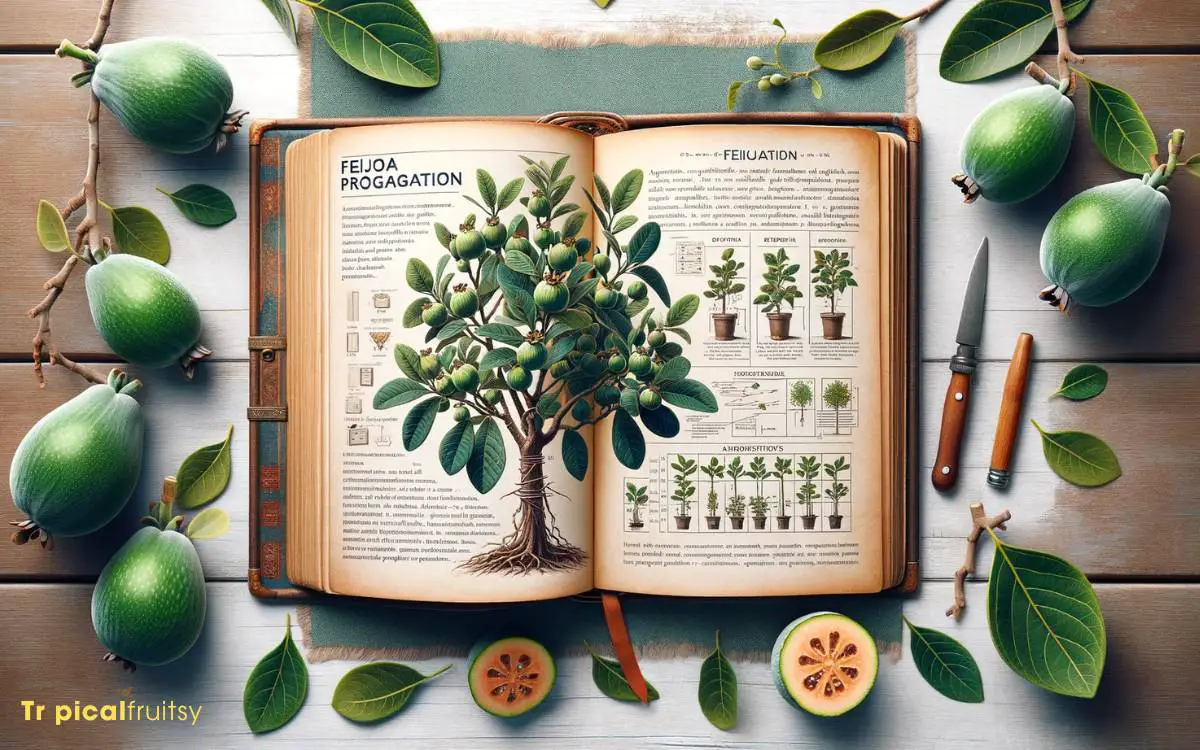
Feijoa propagation through cuttings allows gardeners to clone specific varieties, ensuring genetic consistency in the new plants.
This technique involves severing a healthy, semi-hardwood segment from a mature feijoa plant during the optimal growth phase.
The cutting, typically 6-10 inches long, must have several leaf nodes as these are crucial for root development.
Gardeners then treat the basal end with a rooting hormone to enhance root initiation and insert it into a well-draining propagation medium. The medium’s composition is vital; a blend of perlite, peat, and sand often yields the best results.
Maintaining consistent moisture levels and providing indirect light fosters an environment conducive to root formation.
After several weeks, when the cuttings have established a robust root system, they’re ready for transplantation.
Step 1: Selecting Healthy Cuttings
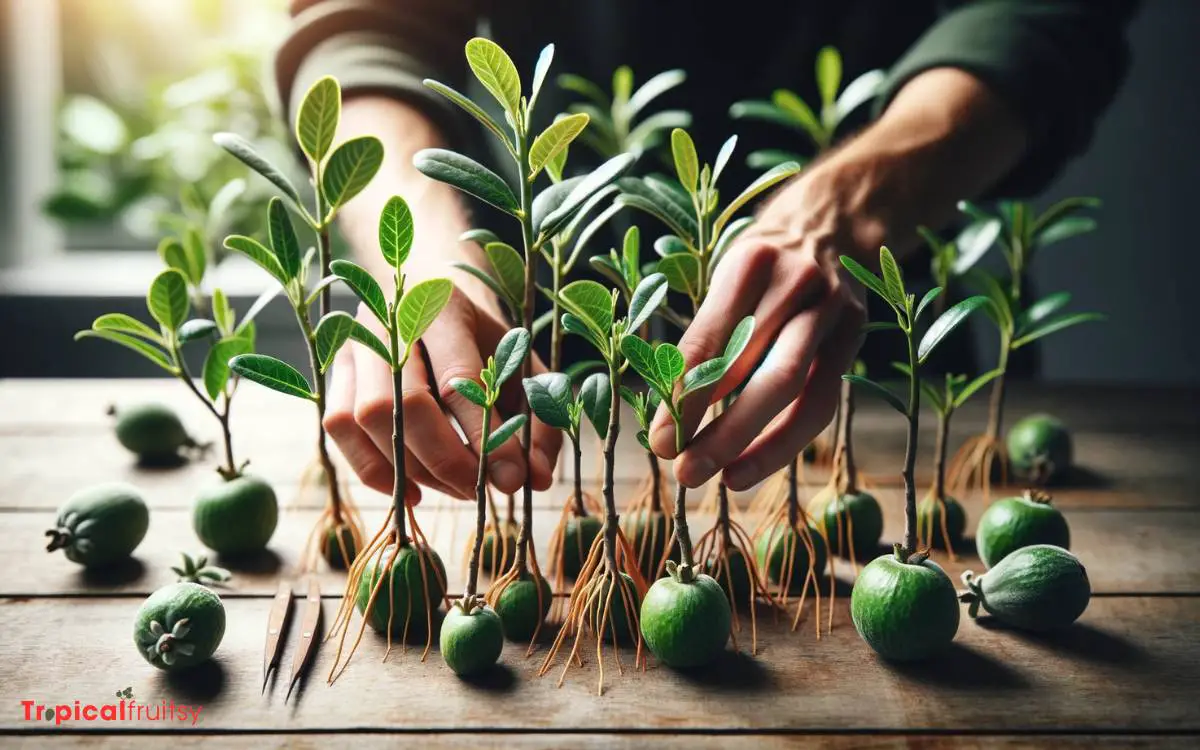
In selecting cuttings for propagation, it’s essential to choose those that are vigorous and free of any signs of disease or damage.
Gardeners should target semi-hardwood segments from the current year’s growth, ideally measuring 6 to 10 inches in length and about a quarter-inch in diameter.
Leaves near the base should be carefully removed to expose the nodes, as this region often yields the most successful root development.
It’s imperative that the selected cutting has a few leaves at the tip to sustain photosynthesis and growth, yet not so many that excessive moisture is lost.
Ensuring the parent plant was healthy and robust enhances the likelihood of successful propagation, as genetic vigor directly influences the cutting’s potential to establish a strong root system and thrive.
Step 2: Preparing Your Tools
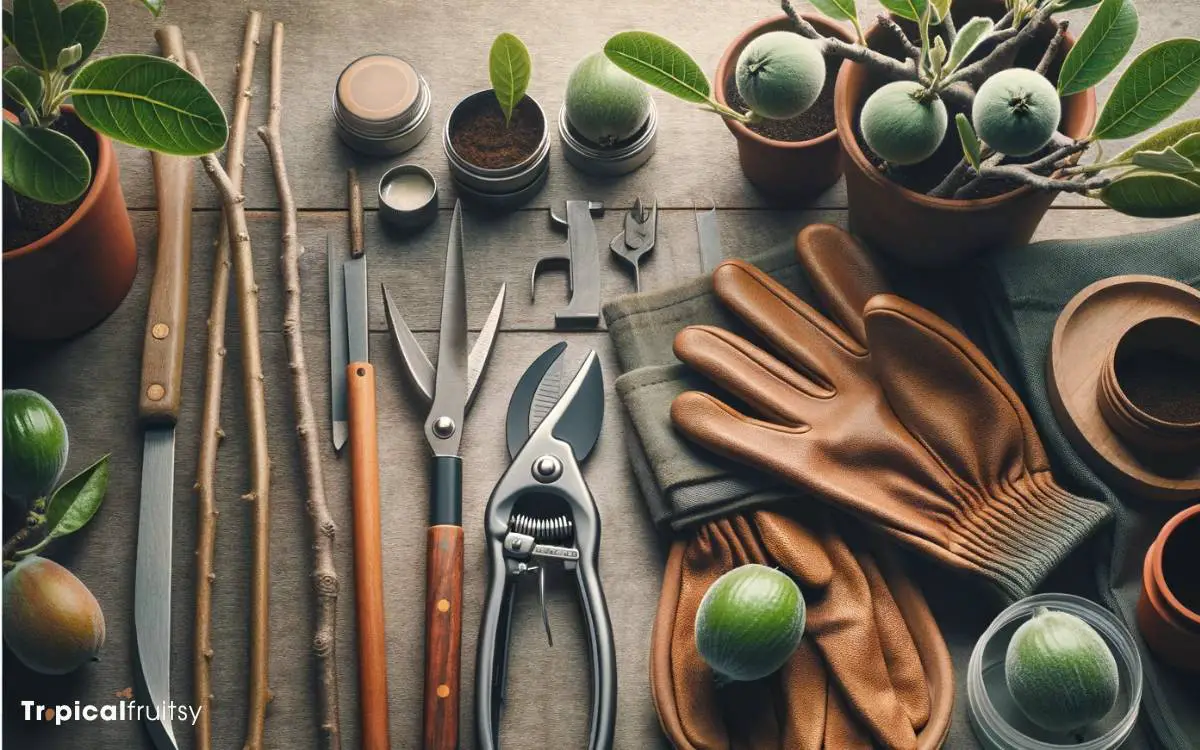
Before moving on to the actual propagation process, it’s crucial to prepare your tools, ensuring they’re clean and sharp to prevent the spread of disease and make precise cuts.
Gardeners should undertake the following steps:
- Sterilize cutting implements, such as pruners or scissors, using isopropyl alcohol or a bleach solution to eliminate potential pathogens.
- Sharpen blades meticulously to achieve clean incisions, which aid in the rapid healing of the cutting.
- Inspect and clean any additional equipment, like pots or planting trays, to ensure they’re free of debris and contaminants.
These preparatory measures are foundational to successful feijoa propagation. With tools in optimal condition, one can now focus on the cutting and trimming techniques that are vital for encouraging root growth.
Step 3: Cutting and Trimming Techniques
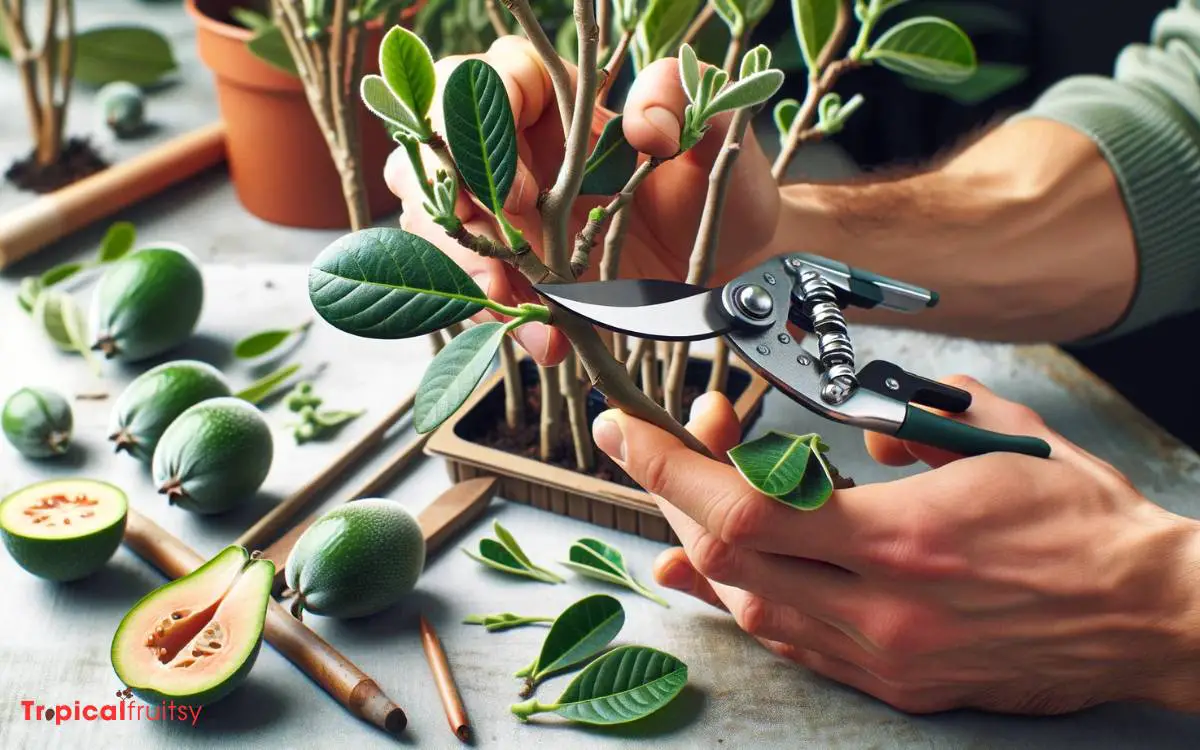
Selecting a healthy, non-flowering shoot from the feijoa plant is the first step in taking a cutting. It is important to choose a shoot that is free of pests and disease.
Once a suitable shoot is identified, look for a segment that is approximately 4-6 inches in length and has at least two sets of leaves.
Using sterilized pruning shears, make a clean, angled cut just below a leaf node. This area contains a high concentration of growth hormones that are conducive to root development.
After making the cut, it is important to carefully remove the leaves from the lower half of the cutting. This helps minimize moisture loss and prevents rot.
If the remaining leaves are large, it may be beneficial to cut them in half to further reduce transpiration.
When trimming the leaves, it is important to do so with precision to avoid unnecessary damage to the plant tissue. Damaging the tissue could impede the cutting’s ability to form roots.
Step 4: Rooting Hormone Application
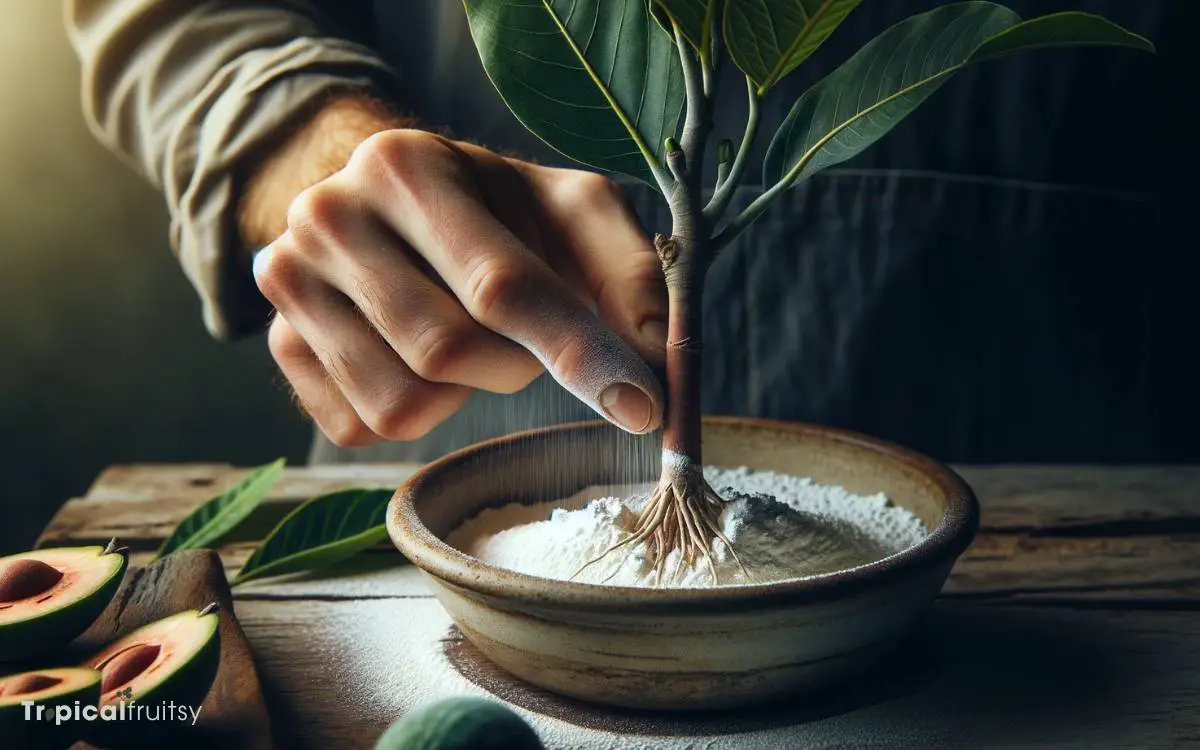
Once you’ve prepared your feijoa cutting, it’s time to apply a rooting hormone to encourage quick and robust root development. This process is critical in the propagation phase to enhance the chances of successful rooting.
Dip the base of the cutting into the rooting hormone powder, ensuring a thin, even coating covers the cut area and the lower nodes. Tap off any excess powder to prevent hormone over-concentration, which can be detrimental to root formation.
Place the cutting in a sterile environment immediately after application to reduce the risk of contamination and to optimize hormone absorption.
Rooting hormone application is a nuanced step that requires precision and attention to detail. With the hormone applied, the stage is set for the next pivotal phase: planting the cuttings into a suitable growing medium.
Step 5: Planting the Cuttings
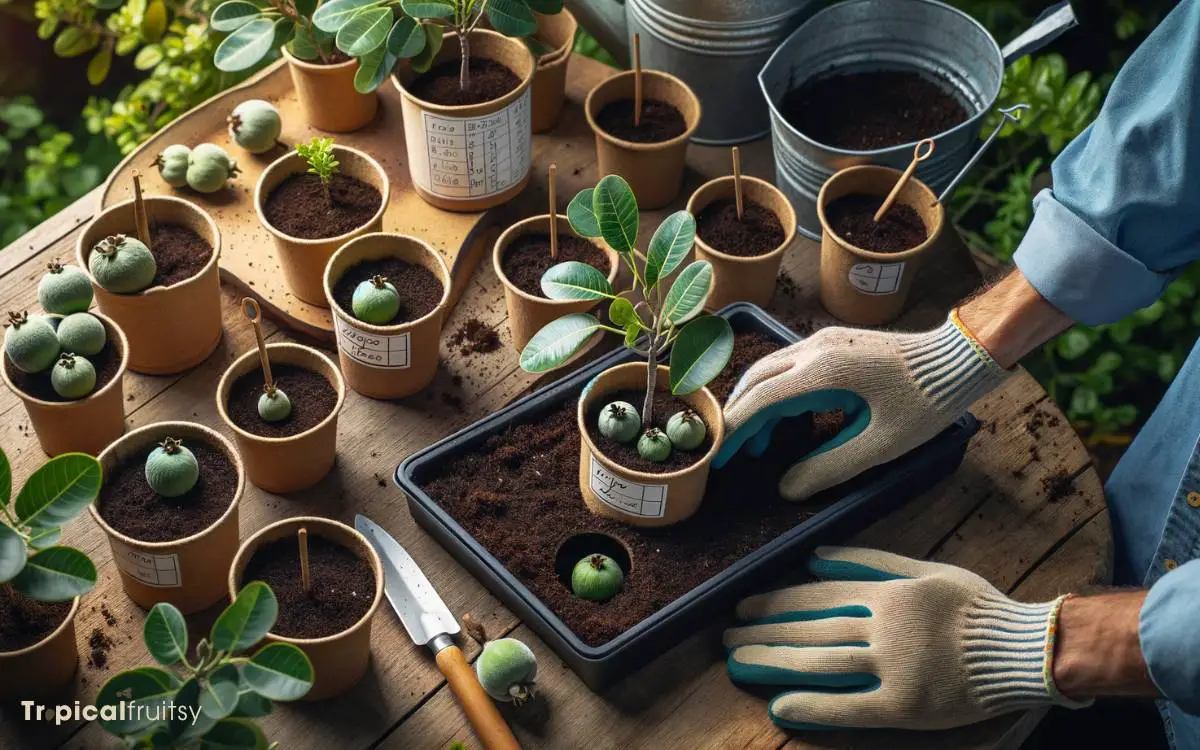
After applying the rooting hormone, plant the feijoa cuttings in moist, well-draining soil to initiate root growth.
Select a potting medium composed of equal parts peat, perlite, and vermiculite to ensure adequate aeration and moisture retention. Fill 4-inch pots with this substrate, leaving a small space at the top.
Create a hole in the center of the medium using a dibble or a pencil, careful not to compact the surrounding soil.
Insert the cutting into the hole, ensuring at least one node is buried where roots will emerge. Gently firm the soil around the base of the cutting to eliminate air pockets and stabilize it.
Water the cuttings lightly to settle the soil, maintaining consistent moisture without over-saturating. Place the pots in a warm, indirect light setting, avoiding direct sunlight that can stress the developing cuttings.
Step 6: Creating the Right Environment
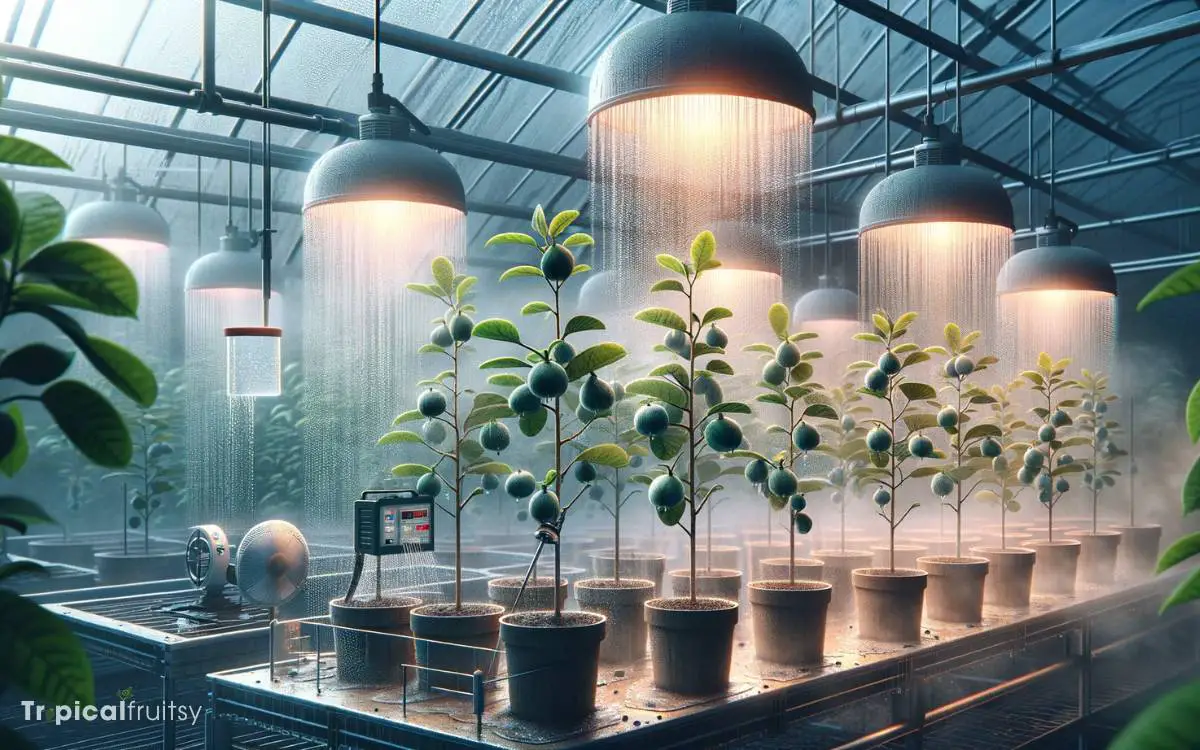
To ensure successful propagation, one must maintain optimal humidity levels for feijoa cuttings. The grower controls temperature within a specific range to support root development.
Precise monitoring and adjustments are crucial in creating an environment conducive to growth.
Optimal Humidity Levels
Maintaining a humidity level around 70-75% is crucial for the successful propagation of feijoa from cuttings. To achieve this, growers must create an environment that consistently sustains this specific range.
This isn’t only to ensure the cuttings don’t dry out but also to promote the development of new root systems.
Here are some methodical steps to regulate humidity:
- Utilize a humidity dome or construct a mini greenhouse around the cuttings.
- Monitor the humidity levels using a reliable hygrometer.
- Mist the cuttings periodically to maintain moisture without over-saturating the soil.
Temperature Control Methods
Ensure the feijoa cuttings are kept at a consistent temperature between 65-75°F (18-24°C), which is vital for their rooting and growth.
To maintain this temperature range, utilize a combination of environmental controls and monitoring techniques.
Here is a detailed table of methods and equipment used in temperature control:
| Method | Equipment |
|---|---|
| Ambient temperature | Thermostat-controlled heater |
| Direct heat source | Heat mats with thermostats |
| Insulation | Thermal covers |
| Monitoring | Digital thermometers |
| Environmental control | Automated climate systems |
Each method contributes to the stabilization of the temperature, ensuring the feijoa cuttings develop in an optimal environment.
Regular monitoring with accurate thermometers is imperative for adjustments. Employing an automated climate control system streamlines the process, providing consistent results.
Step 7: Caring for New Feijoa Plants
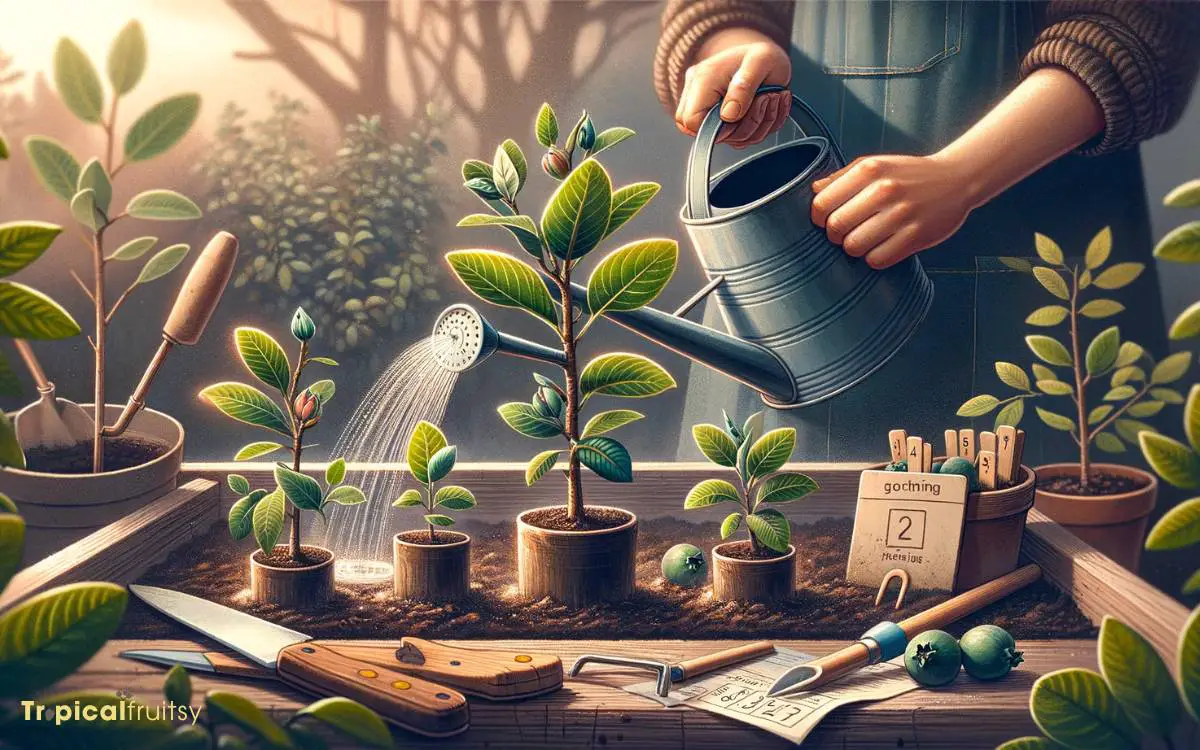
Once your feijoa cuttings have taken root, they’ll need consistent watering and protection from extreme temperatures to thrive.
In the initial stages, maintaining an optimal balance in soil moisture is crucial; it should be damp, not waterlogged, to prevent root rot. As the plants mature, less frequent but deeper watering promotes a robust root system.
To ensure a conducive environment for growth, consider the following:
- Soil Quality: Utilize a well-draining, fertile soil medium, rich in organic matter, to enhance root health and nutrient uptake.
- Fertilization: Implement a balanced, slow-release fertilizer regimen to support steady growth. Adjust based on foliage color and growth rate.
- Pest Management: Monitor regularly for signs of pests or diseases, employing preventative and responsive measures as necessary to maintain plant vigor.
Adhering to these care requirements will facilitate the successful cultivation of feijoa plants from cuttings.
Conclusion
With surgical precision, gardeners wield their sharpened tools, transforming humble feijoa cuttings into verdant forests of promise. A dip in the hormone elixir ensures roots clamber for purchase like eager climbers scaling a cliff.
As these cuttings nestle into their nurturing beds, a microcosm of ideal conditions coaxes forth life with unwavering certainty.
With meticulous care, these miniature saplings will soon burgeon into bountiful feijoa havens, a testament to the cultivator’s masterful propagation prowess.

